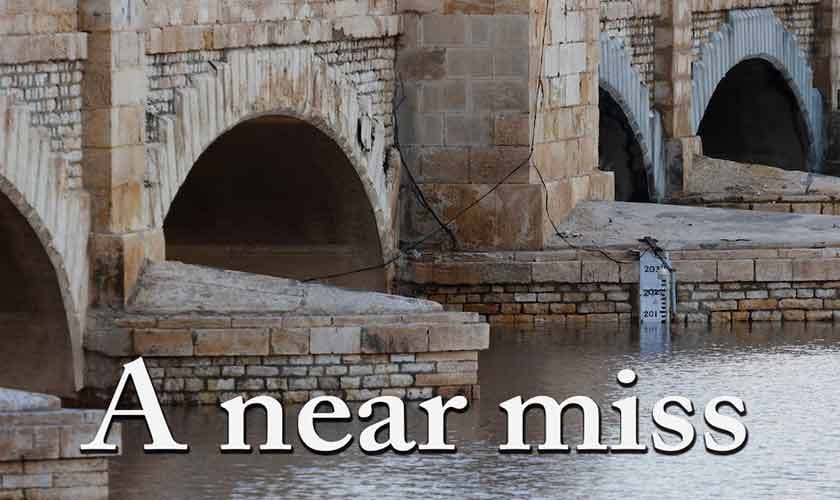After two weeks of devastation in Punjab, floodwaters descended into Sindh in mid-September. A high flood of over 635,000 cusecs crossed the Guddu Barrage. Unlike the two brief high-flood surges in August, this time a flow of over 500,000 cusecs was sustained at Guddu for several days. This surge in water levels at Guddu subsequently increased flows at the Sukkur and Kotri Barrages.
The floodplain, locally known as katcho, was inundated, temporarily displacing more than 175,000 people. Sindh narrowly averted an anticipated monstrous flood of over 900,000 cusecs. Initial projections by the National Disaster Management Authority had even warned of a mind-blowing flood exceeding 1.3 million cusecs at Guddu.
Swollen rivers in Punjab prompted the provincial government to take urgent precautionary measures. The specter of the 2022 flood continues to haunt Sindh, as the province has not fully recovered from the biblical calamity that affected over 14.5 million people, including 12 million who were rendered shelterless.
Sindh’s flat terrain—with a meagre north-to-south gradient of only eight inches per mile—makes it highly vulnerable to various types of floods. The Indus River runs through the middle of the province. It is both a vital source for the agriculture-rich economy and a potential pathway for devastating floods.
Located in the delta of the Indus River system, Sindh receives flows from all tributary rivers traversing the mountains and plains of the Indus basin. For this reason, the province’s three barrages were designed with the highest capacity for flood flows. Sukkur and Guddu were constructed to safely pass flows exceeding one million cusecs.
In 2022, flash floods originating from the Kirthar Hills in Balochistan unleashed a calamity in the right-bank districts of Sindh. Back in 2010, the Indus was expected to carry a manageable flow of about 700,000 cusecs at the Guddu Barrage. However, unanticipated torrential flows from the Koh-i-Suleman Range transformed it into an epic flood.
A sizeable population settled in the katcho area was forced to leave their homes as water levels rose from Guddu to Kotri Barrages.
An unconventional source of flooding in Sindh is the malfunctioning mega drainage projects: the Left Bank Outfall Drain and the Right Bank Outfall Drain. These drains are considered an engineering failure inflicted on the province due to poor planning by WAPDA. Not only have they obstructed several natural waterways, but breaches and backflows in their main channels and feeder drains also cause flooding.
Additionally, the province frequently encounters urban flooding in major cities such as Karachi, Hyderabad, Sukkur, Larkana, and Nawab Shah. The derelict and inadequate drainage networks submerge many neighborhoods under water during intense rain spells. Most cities in the province lack effective stormwater drains, and their sewerage systems lack the capacity to handle heavy downpours along with sanitation needs for a burgeoning population.
This year, Sindh was bracing for a super flood exceeding 900,000 cusecs, the likes of which were last experienced 15 years ago. Flows in the Chenab, Ravi, and Sutlej Rivers witnessed multiple surges during August and September as India received continuous heavy rains. Three of India’s major dams were already full, spilling water into downstream areas.
Indian Punjab also endured a rare flood disaster. Consequently, the plains of Pakistani Punjab became inundated as Indian dams could not absorb the series of flood spates. The overwhelmed Punjab administration struggled with the rivers and resorted to the complex decision of controlled breaches to save vital infrastructure and heavily populated town centers. Over half a dozen controlled breaches, along with several breaches inflicted by unruly river flows, unleashed deluges across hundreds of villages in the province.
Punjab experienced a tormenting month, with more than 4.5 million people—mostly in rural areas—losing their homes, crops, animals, granaries, and modest assets. The badly bruised province is still struggling to recover from this traumatic event. Amidst the havoc, vast plains of the province remained submerged under a sheet of water.
After affecting over 4,700 villages, the floodwaters converged at the Punjnad Barrage before heading towards Sindh. In Jamshoro district alone, 15 major private housing schemes have either been completed or are under construction on protected forest land. Similarly, in neighbouring Hyderabad, at least seven housing projects have been developed within the Indus River’s floodplain.
An anxious Sindh breathed a sigh of relief as much of the flood’s force had already been vented upstream. Nevertheless, a sizeable population settled in the katcho area was forced to leave as water levels rose from Guddu to Kotri Barrages.
As the flood ravaged Punjab, Sindh’s provincial authorities had ample time to swing into action. Targeting a potentially affected population of 1.6 million people, the provincial government acted timely, implementing a rescue and relief plan. Some 45 vulnerable points were identified, and precautionary arrangements were put in place.
In 2022, the administration had been caught unprepared by abnormal rains and failed miserably to tackle the rising water early. This year, it was sheer luck that the Indus River was sluggish and hill torrents lethargic when the peak flows approached Sindh. Coinciding inflows from these two sources could have severely tested the barrages and embankments of the province.
Sindh narrowly survived a perilous flood. The province has a long history of devastating floods and urgently needs a comprehensive flood management plan. Rescue and relief arrangements are only part of the post-flood response. Preparedness remains a weak link in the province’s flood management strategy.
Natural waterways are clogged, urban drainage systems are dilapidated, embankments of canals and distributaries are poorly maintained, and floodplains are heavily encroached upon by illegal zamindara bunds, cropland, and sprawling settlements.
Flood vulnerability persists in Sindh, underscoring the urgent need for improved infrastructure, better urban planning, and comprehensive flood preparedness to safeguard the province and its people from future disasters.
https://www.thenews.com.pk/tns/detail/1345068-a-near-miss

